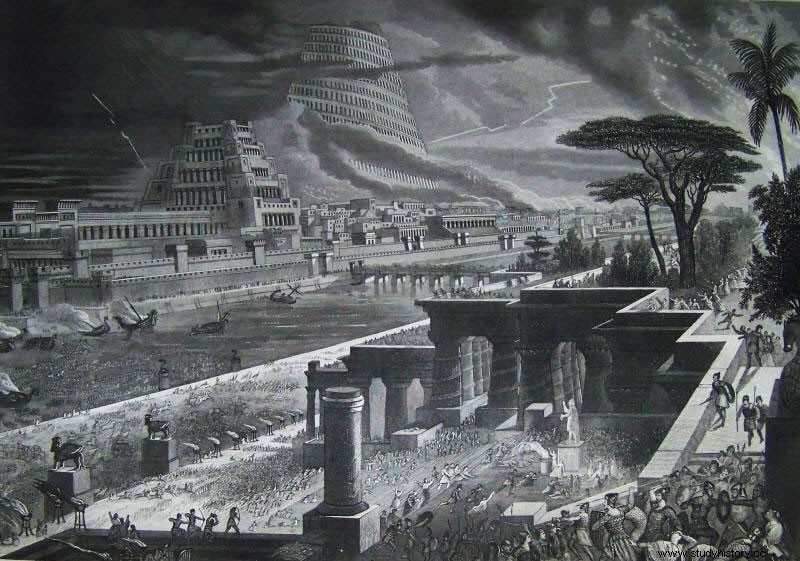It is usually assumed that the first historian was the Greek Herodotus. Actually, there were individuals interested in history before him. The oldest known to us was the king Nabonidus (in Akkadian Nabunaid ), best known in textbooks for the sad circumstance of being the last king of Babylon.
Throughout his life he was a controversial monarch and, furthermore, little loved by his subjects. He came to the throne under unclear circumstances and instead of winning over the powerful, especially the priestly class, what he did was antagonize them. He was the son of a priestess of the god Sin (Moon), which she lived to a ripe old age and influenced the offspring too much. For this he displaced from the main position of the cult to the god Marduk , placing Sin instead. He did not neglect the other cults, but he did make a religious change, and as we well know, moving a god around has nasty side effects on the common folk (and on the priests who see the brush empty).

As a ruler he was disastrous, but he showed a great love for objects and events prior to his reign. He carried out excavations, some of them personally, in the ancient Sumerian and Akkadian cities, already in clear decline, and had the statues of kings and gods that were found, as well as stelae with commemorative texts, transferred to Babylon. It is thought that his desire was to create a place where people admire the glories of the ancient kings, that is, what we would today call " museum ”. Likewise, he did not hesitate to make copies of the hundreds of thousands of tablets in the royal library, for which he had to hire numerous scribes and open workshops. He was so obsessed with preserving the chronicles of the different reigns that he is credited with inventing a special mixture of clay and bitumen with which the tablets were much better preserved. Thanks to this, this library is preserved today in almost its entirety.

But he made the mistake of supporting King Croesus of Lydia in his quarrels with Cyrus II the Great , king of Persia. He, knowing that the people had a grudge against him, decided to seize Babylon. Any other king would have prepared his armies, but Nabonidus preferred to do things his way. He ordered that all the statues of the great gods of Sumer and Akhad be moved to the capital. For all practical purposes, this was equivalent to convening an "assembly of the gods" in Babylon; in short, a religious way of trying to get support for his person from all beings with a horned tiara. But he only managed to anger the cities of the two rivers, which, apart from a battle in which the Babylonians did not participate with much enthusiasm, surrendered to Cyrus without firing a single arrow with the Persian's promise to return the idols to its place. It was no use Nabonidus ordering even the statues that were in poor condition to be repaired. Cyrus entered Babylon acclaimed by the crowd and had the gall to fix the damage to the Enlil's Gate , through which his troops had entered while the Babylonian soldiers pretended that they were not seeing anything (they looked away surreptitiously, filed their nails, whistled popular tunes and talked about women). Cyrus did not find weapons of mass destruction in Babylon, only the statues of the gods that he promptly returned to their temples.
But the objects from the excavations remained in Babylon, since there were no buildings to return them to and, thanks to that circumstance, we found them when excavating at the beginning of the 20th century in the ruins of the city.

Babylon taken by Cyrus
On the one hand, a modern archaeologist would shudder at the thought of how Nabonidus excavated the ruins and his methodology, but some statues or stelae would have been lost forever had it not been for his work. We have an example in those corresponding to the Akkadian Period . When the Babylonian king excavated the ancient capital, Agade , it was little less than a village with four houses. Some time later it ceased to be inhabited and its location was lost. To this day it has not yet been found, and if it is true, as some archaeologists believe, that it would be buried under the outskirts of present-day Baghdad, it could be considered little less than lost forever. Without the intervention of Nabonidus, there would be hardly anything left of the Akkadian kings, nor would we know their history.
Regarding the Babylonian king/archaeologist, it seems that he gave himself as a prisoner to Cyrus II the Great. Some think that he was executed, but we know that the Persian king was not fond of killing other kings. He preferred to give them a warning slap and then spare their lives, as he did with Croesus of Lydia. According to Herodotus, he first sentenced him to death by burning, and when he was before the flames he pardoned him and made him a royal court adviser to him. Another version says that Nabonidus was forgiven and that he ended his days living peacefully in Carmania , perhaps yearning for the museum that he was never able to inaugurate.
Contributed by Joshua BedwyR author of In a Dark Blue World
